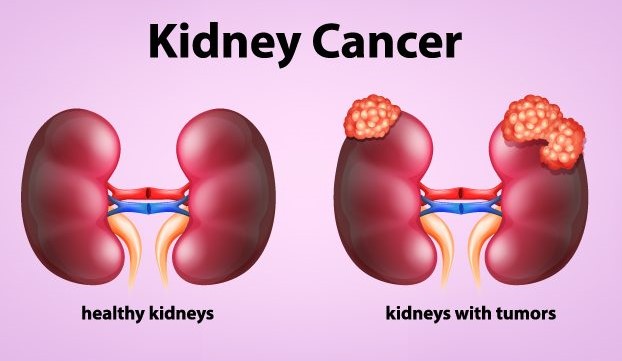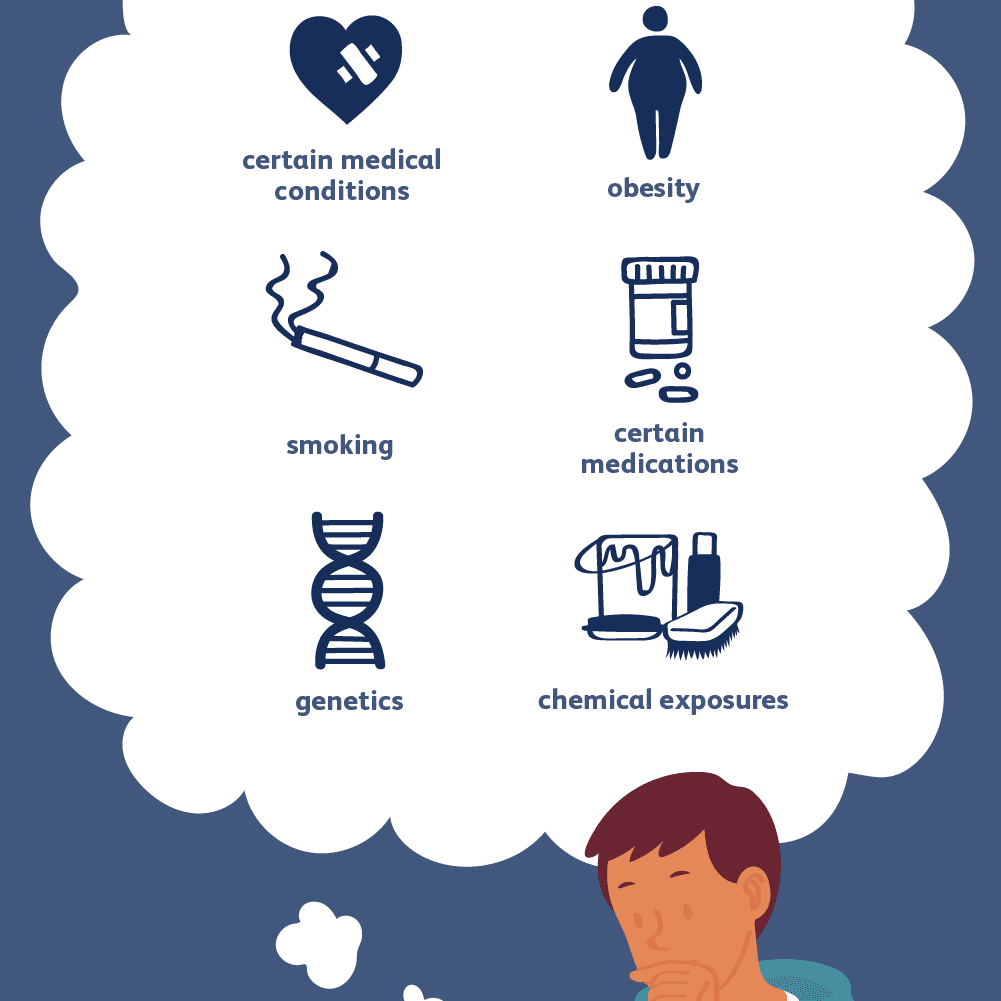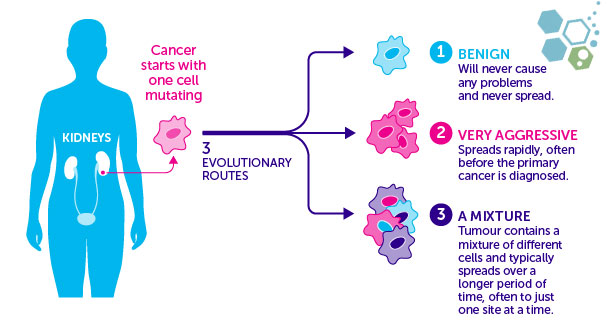
Renal Cancer:
Renal Carcinoma or Kidney Cancer is not a very common disease but it’s general awareness is necessary. What is renal carcinoma? What are it’s causes, signs and symptoms and how renal carcinoma can be cure? It’s very important to know the answers of these questions.
This year on 16th June 2022 (IKCC) affiliate organisations, patients, health care professionals and supporters from around the world came together to mark World Renal Carcinoma or Kidney Cancer Day 2022 with the slogan “We need to talk about treatment options” campaign.

| Table Of Contents 1. What is Renal Cancer? 2. Causes of Renal Cancer 3. Sign and Symptoms 4. Types of Renal Cancer 5. Prevention |
What Is Renal Cancer?
Kidney cancer is a disease that starts particularly within the kidneys. It happens when healthy cells in one or both kidneys grow out of control and starts forming a lump (called a tumor).
Causes Of Renal Cancer:
The reason why kidney cells (nephrons) change and become cancerous is not yet known. We know that people are more likely to develop renal cancer as they age. However, there are certain risk factors linked to this cancer.

Signs And Symptoms:

In the initial stages, most of the people may have signs or symptoms. Renal Cancer is usually found by chance during an abdominal (belly) Imaging Test (IT) for other complaints. On contrary as the tumor grows, you might see some symptoms such as:
- Blood traces in the urine.
- Pain in the lower segment back.
- A lump in the lower segment of back or at side of the waist.
- Unexplained weight loss, night sweats, fever, aches or fatigue.
Risk:
However, a risk factor can be anything that increases your chance of getting a disease. Some risk factors can be change like (smoking, as an example); but others cannot be change (your gender or family history). Having a risk factor, or even several risk factors, does not mean you will get a kidney cancer, but it may increase your risk.
Risk factors for kidney (renal) cancer includes following:
- Smoking.
- Being overweight (obesity).
- High blood pressure.
- Gender – about twice, as many men as compared to women can also develop kidney cancer
- Being on dialysis treatment for advanced chronic kidney disease (CKD).
- Family history with kidney cancer.
- Long-term usage of a pain-relieving drug called (phenacetin).
- Certainly rare genetic diseases, such as von Hippel-Lindau disease, Birt Hogge Dube syndrome, and etc.
- History of long-term exposure to Cadmium or Asbestos.
Moreover, you may be able to lower your risk of developing kidney (renal) cancer by avoiding those risk factors that can be control. For example, quit smoking may lower the risk, controlled body weight and high blood pressure may help as well.
Kidney Disease and Kidney Cancer:
Some studies show there is a connection between kidney cancer and kidney disease.
Kidney Cancer Risk:
Some studies show that people with kidney disease may have a higher risk for kidney (renal) cancer due to:
- Long-term Dialysis: Some studies shows that people on long-term dialysis have a 5-fold increased risk for kidney cancer. Experts believe that this risk is due to kidney disease rather than dialysis.
- Immunosuppressant Medicines: Some anti-rejection medicines that must be take by kidney transplant recipients/acceptor to prevent rejection can increase risk for kidney cancer. However, taking immunosuppressant medicine is important if you have a transplant. Without it, your body will not accept your new kidney.
About one-third of the 300,000 kidney cancer survivors in the United States (US) have or will develop kidney disease.
Types:

RENAL CELL CARCINOMA
Renal cell carcinoma (RCC) is the most common type of kidney cancer find in adults. RCC usually starts in the linings of tiny tubes in the kidney called renal tubules. RCC often stay in the kidneys, but it can spread to other parts of the body, most often the bones, brain or lungs.
CLEAR CELL RENAL CELL CARCINOMA
Clear cell renal cell carcinoma (ccRCC) or conventional renal cell carcinoma, is the most common form of kidney cancer. ccRCC is name after how the tumor looks under the microscope. The cells in the tumor look clearly like bubbles.
In adults, ccRCC makes up almost about 80% of all renal cell carcinoma cases. ccRCC is more common in adults than in children. Renal cell carcinoma makes up 2% – 6% of childhood and young adult kidney cancer cases.
RARE TYPES OF KIDNEY CANCER
Rare kidney cancers diagnosed most frequently in children, teenagers, and young adults.
PAPILLARY RENAL CELL CARCINOMA (PRCC)
- 15% of all renal cell carcinomas (RCC).
- Tumor(s) located in the kidney tubules.
- Type 1 PRCC is more common and results slow growth.
- Type 2 PRCC is more aggressive and hence grows more quickly
TRANSLOCATION RENAL CELL CARCINOMA (TRCC)
- Accounts for 1% – 5% of all renal cell carcinomas (RCC) and 20% of childhood cases
- Tumors located in the kidney
- TRCC usually grows slowly often without any symptoms in children.
- In adults, TRCC tends to be aggressive and grow rapidly.
BENIGN (NON-CANCEROUS) KIDNEY TUMORS
Benign, or noncancerous kidney tumors grow in size but do not spread to other parts of the body and usually are not life-threatening. Surgical removal of the tumor is the most common treatment and most tumors do you come back.
PAPILLARY RENAL ADENOMA
- The most common form of benign kidney tumor
- Tumors are small in size, grow slowly, and often found without any symptoms
- Usually, a coincidental finding on an imaging test done for a different reason
ONCOCYTOMA
- Tumors start in the cells of kidney’s collecting ducts and tumors can grow in one of the both kidneys
- The tumors can grow up to a large size. These tumors can grow quite larger, starting at just over an inch (walnut) and growing up to 4 inches (grapefruit).
ANGIOMYOLIPOMA
- Benign fatty tumors may also be due to overgrowth of blood vessels and smooth muscle tissue cells.
- These tumors are non-cancerous, but they can become very large and destroy surrounding tissue.
- Tumors that are over an inch and a half in size can cause internal bleeding.
Tests:
Your doctor will diagnose kidney cancer by go through your medical history and doing a physical exam, along with blood, urine and other tests.
IMAGING TESTS:
- Computed tomography (CT) scans use x-rays to make a complete picture/scan of the kidneys and abdomen (belly). It can be do with/without a contrast dye moreover small amounts of radiation are use in some scans. The CT scan imaging often shows if a tumor appears cancerous or if it has spread beyond the kidney.
- Magnetic resonance imaging (MRI) scans make a complete picture/scan of the kidneys and abdomen, but without radiation. An MRI can be do with contrast or without contrast dye called “Gadolinium” that should be avoid in people on dialysis or with very low kidney functioning.
- Ultrasound uses sound waves to give a complete picture/scan of the kidneys and abdomen without radiation. It may be useful in helping to decide if a mass in the kidney is a fluid-filled cyst or a solid tumor. This test is done without contrast dye (Gadolinium).
- Biopsy can be use in special cases, but it is typically not recommend. A biopsy require a very small piece of the kidney to be remove with a needle and then tested for cancer cells.
Treatment:
- Active Surveillance
- Ablation
- Cryoablation (Coldablation)
- Radiofrequency (Hotablation)
- Partial Nephrectomy
- Radical Nephrectomy
Prevention:
- Do not smoke
- Maintain healthy weight
- Furthermore find out if you are expose to certain toxins at work or at home (such as Cadmium, Asbestos, and Trichloroethylene, which may increase risk of kidney cancer)
How To Take Care Of Your Kidneys?
People with kidney disease(s) may be at increased risk for kidney cancer. Ask your healthcare provider about 2 simple tests to find your kidney score:
- A blood test for kidney function called (GFR)
- A urine test to look for kidney damage called (ACR)
- Manage blood pressure too
- Manage your blood sugar level if you have diabetes
- Lastly, avoid prolonged use of non-steroidal anti-inflammatory drugs (NSAIDs) such as ibuprofen and naproxen